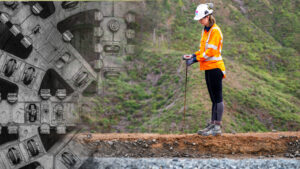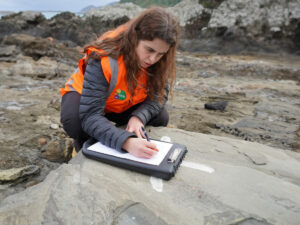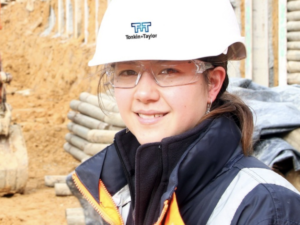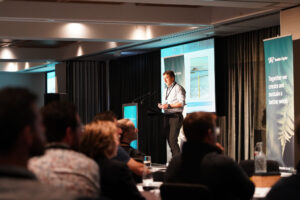We’re honoured to celebrate recognition of the SH25A Taparahi Bridge project, named Gold award winner at the 2024 ACE NZ Awards!
 This critical project highlights the importance of speed, innovation, and cooperation in modern engineering solutions. Below, we explore the key takeaways and engineering insights from this milestone project, focusing on what it means for future infrastructure initiatives.
This critical project highlights the importance of speed, innovation, and cooperation in modern engineering solutions. Below, we explore the key takeaways and engineering insights from this milestone project, focusing on what it means for future infrastructure initiatives.
After the devastating weather events of 2023 that wiped out 120 metres of Coromandel’s State Highway 25A, reconnecting the region became urgent. The road was a lifeline for communities, and its closure had significant economic impacts.
Tonkin + Taylor worked as an integrated team with our partners, Beca on Design, as well as our constructor clients, McConnell Dowell and Fulton Hogan, solving the complex combination of programme and design to create a solution for our clients and the communities this project will benefit.
Our team developed a solution that allowed the bridge – spanning the major slip area – to be designed and constructed in just seven months. By working closely with our partners, we were able to set a new industry standard for rapid, safe infrastructure recovery, delivering results that exceeded expectations.
- 12 Month Timeline Reduction: The project shaved significant time off the usual bridge design and construction timeline, setting a new industry standard
- 100m Road Loss Reinstated: Over 100 meters of SH25A was lost due to severe storm damage
- 124-Metre Bridge: The Taparahi Bridge is 124 meters long, replacing the lost section of the highway
- 90% Traffic Recovery: After reopening, vehicle traffic on SH25A recovered to 90.88% of pre-closure levels
- $69 Million Boost: Regional tourism was boosted by $69 million due to the early reopening of the highway
The successful reconstruction of the SH25A Taparahi Bridge after devastating storm damage in early 2023 is a prime example of New Zealand’s commitment to resilient infrastructure.

The Challenge: A Vital Arterial Link Severed
In January 2023, a series of major storm events caused significant damage to State Highway 25A (SH25A), a vital route connecting communities on the Coromandel Peninsula. The most severe impact was the total collapse of a 100-metre section of the highway, leaving residents and businesses isolated. The severance of SH25A resulted in severe disruptions to transport, with far-reaching consequences for local tourism, businesses, and daily life.
The Solution: A Bridge to Reconnect
Faced with the immense challenge of restoring this critical route, our integrated team of engineering consultants and contractors opted for a resilient and rapid solution: a 124-metre multi-span bridge. While alternative options, including a bypass or road rebuild, were explored, the bridge solution proved the most viable in terms of safety, reliability, and the shortest timeframe for completion.

Engineering Ingenuity: The Fast-Tracked Process
In a typical setting, a bridge of this scale might take 18 to 24 months to design and construct. However, the Taparahi Bridge project was completed in less than 12 months, a remarkable feat made possible through innovative design and procurement strategies.
Key factors in the project’s accelerated timeline included:
- Early Geotechnical Investigations: This provided critical insights into site conditions, enabling rapid decision-making and design formulation.
- Off-Site Prefabrication: Key components were fabricated off-site and brought in, reducing delays caused by adverse weather conditions and on-site constraints.
- Use of Standardised Designs: Leveraging existing bridge designs minimised lead times, allowing construction to commence even as design processes continued in parallel.
- Creative Resource Utilisation: Locally available materials and resources were maximised to expedite construction, with steel plate bridge beams sourced from another ongoing project and repurposed for immediate use.
Procurement and Collaboration: A New Model for Success
The success of the SH25A Taparahi Bridge project also stemmed from a departure from traditional procurement methods. A more flexible and responsive approach was adopted under the Ministry of Business, Innovation and Employment’s emergency procurement guidelines. This accelerated the tender process, allowing a contractor to be appointed within a month.
Key to this process was the shift in focus from lowest-cost bids to a model that prioritised attributes such as team capability and the ability to meet tight deadlines. This attribute-based selection and a cost-reimbursement contract ensured that the project progressed without delays often associated with commercial negotiations.
Lessons in Resilience: Adapting to Emergency Provisions
The Taparahi Bridge project underscores the value of emergency provisions in infrastructure projects. By leveraging fast-tracked consenting and exemptions from the Building Act, the project team bypassed lengthy bureaucratic processes, further speeding up delivery. While these provisions were essential given the project’s emergency nature, they also offer important lessons for non-emergency scenarios.
Adopting fast-track consenting and attribute-based procurement models could significantly improve the pace and efficiency of future infrastructure projects, especially those with high economic or social value.
This project highlights the economic benefits of fast-tracking infrastructure recovery in disaster-affected areas. Projects like Taparahi Bridge enable faster returns to productive use by reducing downtime and restoring access to vital routes, underscoring the importance of resilience planning in long-term infrastructure strategies.
 Future-Proofing Infrastructure: Recommendations for Improvement
Future-Proofing Infrastructure: Recommendations for Improvement
The SH25A Taparahi Bridge project provides valuable insights that can be applied to future infrastructure projects. Recommendations for improving New Zealand’s infrastructure planning and delivery include:
- Emphasise Value-Based Decision-Making: Instead of focusing solely on cost, future projects should consider broader value, including economic, social, and environmental impacts.
- Standardise Designs Where Appropriate: Nationally standardised designs, particularly for critical infrastructure like bridges, can help streamline project timelines and reduce costs without compromising quality.
- Prefabrication as a Key Strategy: Off-site fabrication should be considered for projects where weather conditions or site constraints pose risks to timelines.
- Foster Collaboration Across Sectors: The high level of trust and collaboration between government agencies, contractors, consultants, and the local community was key to the project’s success. Future projects should aim to replicate this model of shared goals and open communication.
- Prepare for Future Emergencies: Establishing a national or regional emergency infrastructure panel could further expedite responses to future natural disasters, ensuring that New Zealand is better prepared to rebuild faster and more efficiently.
A Model for Resilient Infrastructure
The SH25A Taparahi Bridge project is a model for how New Zealand can approach infrastructure delivery in a more resilient, efficient, and collaborative manner. The lessons learned from this project provide a roadmap for future improvements in planning, procurement, and construction, helping to ensure that New Zealand’s infrastructure is ready to meet future challenges.
By focusing on speed, collaboration, and innovation, the Taparahi Bridge rebuild showcases what is possible when the engineering community comes together with a shared vision. This project reconnected communities in the Coromandel and laid the groundwork for a more resilient infrastructure future across the country.
Read more about Tonkin + Taylor’s transport projects.
























